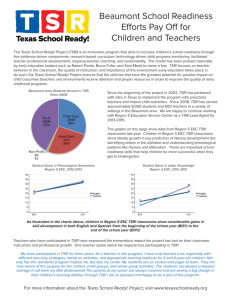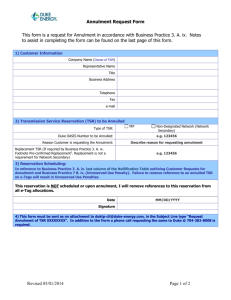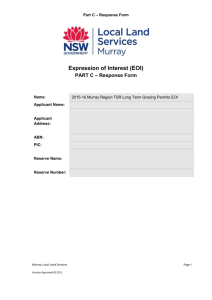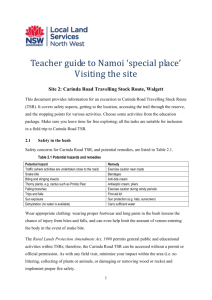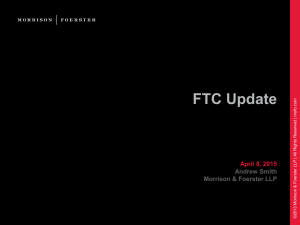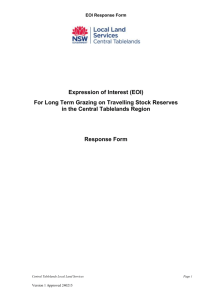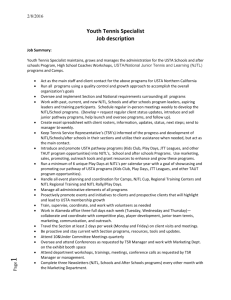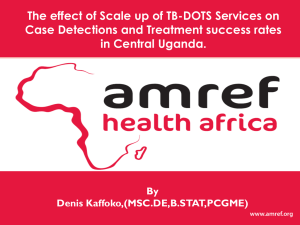The Telemarketing Sales Rule applies only to
advertisement
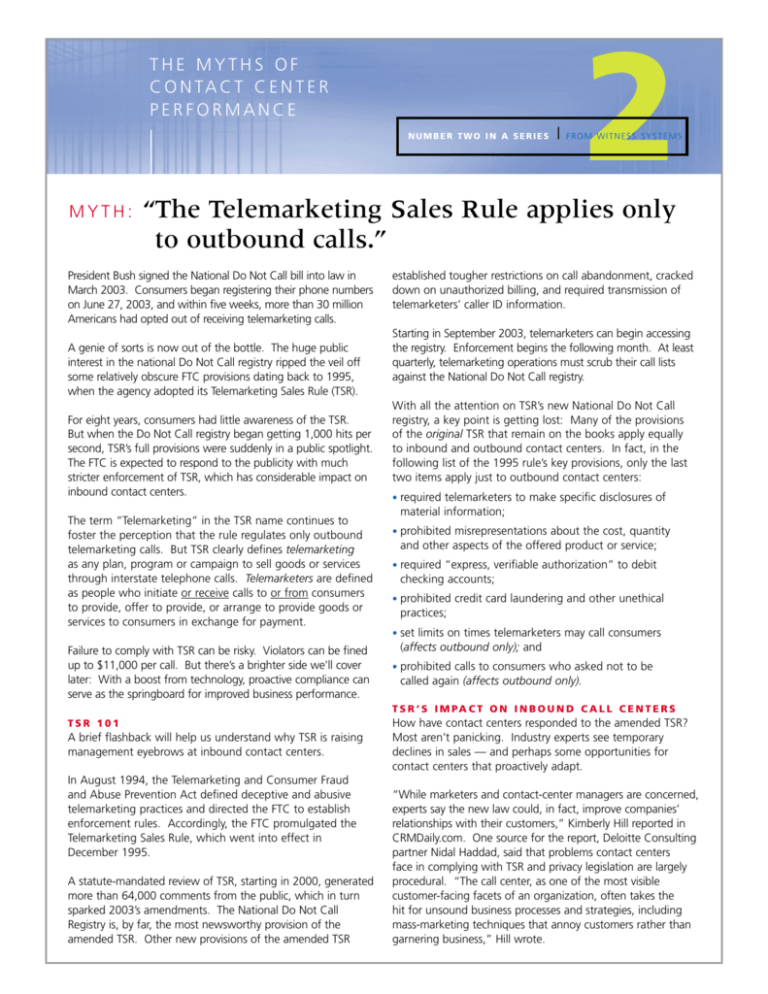
THE MYTHS OF C O N TA C T C E N T E R PERFORMANCE NUMBER TWO IN A SERIES MYTH: | 2 FROM WITNESS SYSTEMS “The Telemarketing Sales Rule applies only to outbound calls.” President Bush signed the National Do Not Call bill into law in March 2003. Consumers began registering their phone numbers on June 27, 2003, and within five weeks, more than 30 million Americans had opted out of receiving telemarketing calls. A genie of sorts is now out of the bottle. The huge public interest in the national Do Not Call registry ripped the veil off some relatively obscure FTC provisions dating back to 1995, when the agency adopted its Telemarketing Sales Rule (TSR). For eight years, consumers had little awareness of the TSR. But when the Do Not Call registry began getting 1,000 hits per second, TSR’s full provisions were suddenly in a public spotlight. The FTC is expected to respond to the publicity with much stricter enforcement of TSR, which has considerable impact on inbound contact centers. The term “Telemarketing” in the TSR name continues to foster the perception that the rule regulates only outbound telemarketing calls. But TSR clearly defines telemarketing as any plan, program or campaign to sell goods or services through interstate telephone calls. Telemarketers are defined as people who initiate or receive calls to or from consumers to provide, offer to provide, or arrange to provide goods or services to consumers in exchange for payment. Failure to comply with TSR can be risky. Violators can be fined up to $11,000 per call. But there’s a brighter side we’ll cover later: With a boost from technology, proactive compliance can serve as the springboard for improved business performance. established tougher restrictions on call abandonment, cracked down on unauthorized billing, and required transmission of telemarketers’ caller ID information. Starting in September 2003, telemarketers can begin accessing the registry. Enforcement begins the following month. At least quarterly, telemarketing operations must scrub their call lists against the National Do Not Call registry. With all the attention on TSR’s new National Do Not Call registry, a key point is getting lost: Many of the provisions of the original TSR that remain on the books apply equally to inbound and outbound contact centers. In fact, in the following list of the 1995 rule’s key provisions, only the last two items apply just to outbound contact centers: • required telemarketers to make specific disclosures of material information; • prohibited misrepresentations about the cost, quantity and other aspects of the offered product or service; • required “express, verifiable authorization” to debit checking accounts; • prohibited credit card laundering and other unethical practices; • set limits on times telemarketers may call consumers (affects outbound only); and • prohibited calls to consumers who asked not to be called again (affects outbound only). T S R ’ S I M PA C T O N I N B O U N D C A L L C E N T E R S TSR 101 A brief flashback will help us understand why TSR is raising management eyebrows at inbound contact centers. In August 1994, the Telemarketing and Consumer Fraud and Abuse Prevention Act defined deceptive and abusive telemarketing practices and directed the FTC to establish enforcement rules. Accordingly, the FTC promulgated the Telemarketing Sales Rule, which went into effect in December 1995. A statute-mandated review of TSR, starting in 2000, generated more than 64,000 comments from the public, which in turn sparked 2003’s amendments. The National Do Not Call Registry is, by far, the most newsworthy provision of the amended TSR. Other new provisions of the amended TSR How have contact centers responded to the amended TSR? Most aren’t panicking. Industry experts see temporary declines in sales — and perhaps some opportunities for contact centers that proactively adapt. “While marketers and contact-center managers are concerned, experts say the new law could, in fact, improve companies’ relationships with their customers,” Kimberly Hill reported in CRMDaily.com. One source for the report, Deloitte Consulting partner Nidal Haddad, said that problems contact centers face in complying with TSR and privacy legislation are largely procedural. “The call center, as one of the most visible customer-facing facets of an organization, often takes the hit for unsound business processes and strategies, including mass-marketing techniques that annoy customers rather than garnering business,” Hill wrote. In this soft economy, acquiring new customers isn’t easy, so the inbound caller is now a much riper target for selling. Top management knows that inbound callers represent an audience highly receptive to its sales messages. Many organizations will expect inbound contact centers to make up the slack in the outbound channel through increased up-selling and cross-selling. TSR magnifies the importance of blending sales and service skills. With the lines between sales and service diminishing, inbound contact center managers need to work closely with their agents. Many agents are uncomfortable with sales, and will therefore need training, patience and understanding to successfully handle their new dual role. TSR may also cause a huge operational impact at contact centers. No longer can a TSR-compliant center function as a silo separate from the rest of the organization. The rule mandates extensive record keeping. The required records, many of which must be kept for two years, aren’t all in the usual domain of the contact center. For example, the organization will need to keep records of sales transactions, prize recipients, advertising and promotional materials, and records of employees involved in the transaction. If an allegation of fraud or misrepresentation arises, all of these records could be pertinent in resolving the conflict. So TSR’s requirements will encompass the marketing organization, the sales organization, the human resources people, and any other group responsible for customer information or transaction information. The Information Technology (IT) group will need to understand the business drivers behind the TSR in order to establish the process needed to bring all of this information together from a technical standpoint. IT will be the gatekeeper for call monitoring technology that not only complies with TSR, but also helps agents grow professionally and helps the organization to optimize contact center performance. WHEN YOU’RE HANDED LEMONS, MAKE LEMONADE There’s no secret about the catalyst for the National DNC registry and stricter enforcement. The industry was lax. It got away from sound, fair practices. Consumers reacted loudly, and that’s why we now have tougher rules, more records to keep and a diminishing universe of people willing to accept telemarketing calls. But there’s no need to panic. TSR isn’t really a threat for inbound contact centers that follow good business practices. Instead of dreading TSR, organizations should be proactive and embrace its provisions and its intent. That’s why many organizations that are exempt from TSR (such as insurance companies, long distance telephone companies, banks and airlines) are voluntarily complying with it. The organization that conducts its business in an efficient, ethical manner will achieve what everyone wants: high customer satisfaction. The key to implementing TSR, then, is to look at its provisions as best practices that should have already been in place. Think of TSR as a roadmap that will help the organization to sell in a more professional way. Considered in this light, TSR’s provisions aren’t barriers to business; on the contrary, they facilitate sales that stick. A few examples: • Disclosing information in a clear and conspicuous manner, communicated just as effectively as the sales message, will build agent credibility. • The consumer will appreciate authorization procedures as a step that protects both parties. • Record keeping — even HR records and other records not generated or maintained by the contact center itself — is a good business practice for reasons that go far beyond compliance. FOUR SECRETS TO SUCCESS WITH TSR 1. Explain the “big picture” to agents and their supervisors. Don’t assume that you’ll gain TSR compliance through heavy-handed supervision. Once agents understand TSR, why consumer protection issues are important, and why their “buy-in” is critical to meeting individual and corporate goals, they will embrace the changes needed in their processes. 2. “Inspect what you expect.” Agent training needs to include what is expected of each individual — and why. Then you need to regularly measure performance to see if the expectations have been met. Find out how TSR impacts your close rate. You may need to modify scripts or rework the sequence of screens to better fit the flow of a sales conversation. 3. Use technology to monitor compliance with TSR according to user-defined business events, such as completed sales transactions and customer declines. By identifying skill deficiencies and correcting them through e-learning, management can use TSR compliance as a springboard for optimizing the contact center’s performance. 4. Reward agents for the right behaviors. You may want to rethink performance measurements that emphasized speed (for example, average handle time) over quality (for example, first call resolution). For years, contact center managers have tried to gain internal recognition of the contact center’s strategic corporate role. If TSR is perceived as a cornerstone of the enterprise’s best practices, respect for the contact center will soar. In the long run, that may be TSR’s greatest potential upside. ABOUT WITNESS SYSTEMS Witness Systems (NASDAQ: WITS) provides the contact center industry’s first integrated performance optimization software suite to help global enterprises capture customer intelligence and optimize workforce performance. Comprised of businessdriven multimedia recording, performance analysis and e-learning management applications, the browser-based eQuality® solution is designed to enhance the quality of customer interactions across multiple communications media. For additional information about Witness Systems and its eQuality software suite, visit www.witness.com, or call 1.888.3.WITNESS.
